Cracking codices: 10 of the most mysterious ancient manuscripts
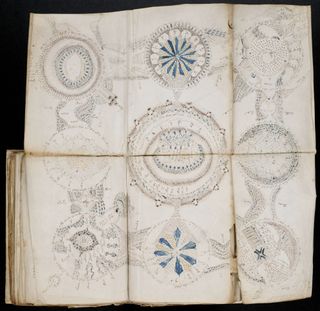
Dating back hundreds to thousands of years, codices can reveal much about an ancient culture, that is, if you can decipher the text. Often written in an outdated language with unfamiliar grammar, these codices take careful analysis to crack their meanings. Some continue to completely baffle archaeologists and other scientists, while others have divulged just enough of their meaning to intrigue.
From an Egyptian book full of magic spells to a text written in an unknown language, Live Science takes a look at 10 of the most mysterious ancient manuscripts.
Related: Check out the 14 biggest historical mysteries that may never be solved.
Liber Linteus
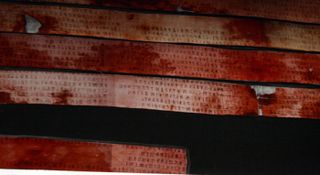
Preserved in the wrappings of an Egyptian mummy, this text is written in Etruscan, a language that was used in Italy in ancient times. Dating back about 2,200 years, the mummy and its removed wrappings are now in the Zagreb Museum in Croatia.
The text's meaning is not entirely clear. It was "classified as a funerary calendar in the past, but nowadays, it is usually labelled as a ritual calendar, although months are only mentioned from column 6 onwards," Lammert Bouke van der Meer, a professor at Leiden University, wrote in an essay published in the book "Votives, Places and Rituals in Etruscan Religion" (Brill, 2008).
In ancient Egypt, it was common for materials to be reused as mummy wrapping or to make mummy masks. Additionally, trade was widespread in the Mediterranean in ancient times, and it was not unusual for goods to be transported between Italy and Egypt according to ancient records and archaeological finds.
Gospel of the Lots of Mary
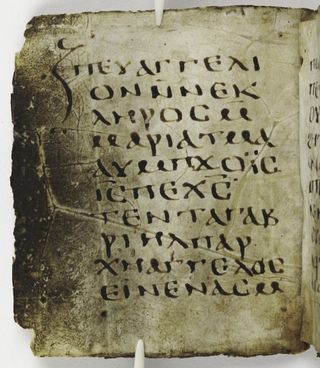
The "Gospel of the Lots of Mary," as the ancient text is called, is a gospel like no other. Written in Coptic (an Egyptian language) and dating back around 1,500 years, the Gospel of the Lots of Mary doesn't discuss the life of Jesus, but instead contains a series of 37 oracles, written vaguely, with only a few words that mention Jesus.
The opening to the book begins as follows: "The Gospel of the lots of Mary, the mother of the Lord Jesus Christ, she to whom Gabriel the Archangel brought the good news. He who will go forward with his whole heart will obtain what he seeks. Only do not be of two minds."
The text, now at Harvard University, was deciphered, and details were published in 2014 by Anne Marie Luijendijk, a professor in the Department of Religion at Princeton University. In her book "Forbidden Oracles? The Gospel of the Lots of Mary" (Mohr Siebeck, 2014)," she wrote that the gospel would have been used for divination, an attempt to predict the future. A person seeking an answer to a question could have sought out the owner of this book, asked a question and gone through a process that would randomly select one of the 37 oracles to help find a solution to the person's problem. How the process would have worked is unknown. Though it's unclear how the book reached the United States, it was donated to Harvard in 1984.
Dresden Codex
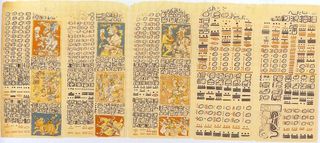
The Dresden Codex is a Mayan text dating back around 800 years; it contains 39 beautifully illustrated sheets with texts and images on both sides. Research published in 2016 in the Journal of Astronomy in Culture indicates that the codex records the phases of the planet Venus so that the Maya would be certain that their ceremonial events were being held on the correct day.
The Maya "had a really elaborate ritual set of events that were tied to the calendar," study researcher Gerardo Aldana, a science historian at the University of California, Santa Barbara, told Live Science. "They were probably doing large-scale ritual activity connected to the different phases of Venus."
The codex first appeared in Europe at The Royal Library in Dresden, Germany, in the 1730s. How it got there is unclear. Many Mayan texts were destroyed by zealous Christian missionaries trying to wipe out any non-Christian beliefs.
Gospel of Judas
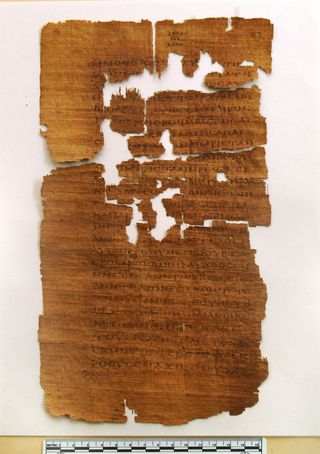
In 2006, the National Geographic Society published a translation of the third-century text called the "Gospel of Judas" that may depict Judas Iscariot — who, in the New Testament, betrayed Jesus — in a positive light. Some scholars claim that the text, written in Coptic, describes Jesus asking Judas to betray him so that he could be crucified and ascend into heaven.
However, experts disagree over the translation and interpretation of the text. April DeConick, a professor of religion at Rice University in Houston, said the text actually declares Judas to be a "daimon" (demon). Tests on the gospel's inkindicate that it is authentic, according to a team led by microscopist Joseph Barabe of McCrone Associates in Illinois.
Treatise of the Vessels
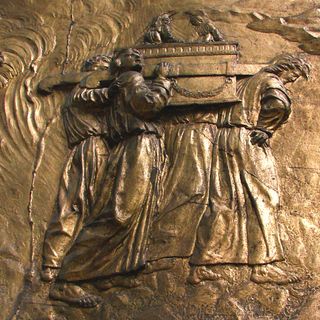
The "Treatise of the Vessels" is a Hebrew text that claims to reveal where treasures from King Solomon's temple were hidden, and discusses the fate of the Ark of the Covenant. The text says the Ark, along with other treasures, "shall not be revealed until the day of the coming of the Messiah son of David …" — putting it out of reach of any would-be treasure seeker.
The earliest surviving copy of the text dates to 1648; James Davila, a professor at the University of St Andrews in Scotland, studied and translated that copy of the text. "The writer draws on traditional methods of scriptural exegesis [interpretation] to deduce where the treasures might have been hidden, but I think the writer was approaching the story as a piece of entertaining fiction, not any kind of real guide for finding the lost Temple treasures," Davila told Live Science in an email.
Davila published his translation and interpretation of the text in the book "Old Testament Pseudepigrapha: More Noncanonical Scriptures Volume 1" (William B. Eerdmans Publishing Co., 2013).
Popol Vuh
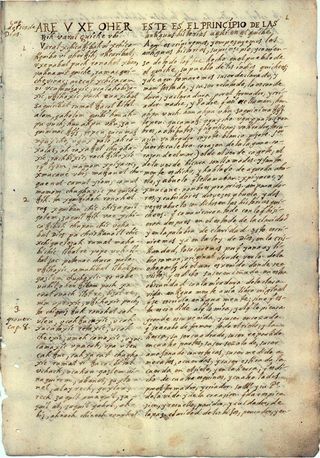
The Popol Vuh, which translates to "Book of Counsel," is a mythical origin story told by the K'iche' Maya(who are based in Guatemala). According to the stories, the forefather gods Tepew and Q'ukumatz "brought forth the earth from a watery void, and endowed it with animals and plants," wrote Michael Coe, a professor at Yale University, in his book "The Maya" (Thames and Hudson, 2011).
The story says that the gods had difficulty creating humans and describes how they eventually created the hero twins, Hunahpu and Xbalanque. The twins embarked on a series of adventures, which included defeating the lords of the underworld. The earliest surviving copy of the Popol Vuh dates to 1701 and was recorded in Spanish by the Dominican priest Francisco Ximénez. A copyof the text is in the Newberry Library in Chicago.
Copper Scroll
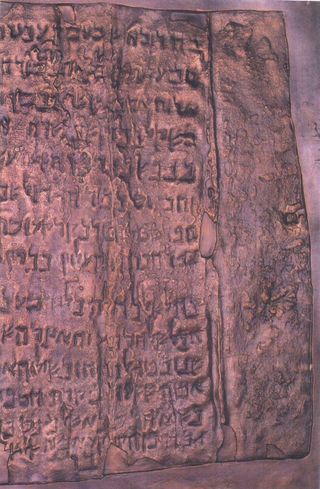
The Copper Scroll is a Hebrew text inscribed on copper sheets found in cave 3 at Qumran in the Judean Desert along with other Dead Sea Scrolls. The text records details of a vast amount of hidden treasure that includes gold, silver, vessels and coins. The scroll dates to around A.D. 70, a time when the Roman army laid siege to Jerusalem and the second templewas destroyed.
Scholars continue to debate whether the treasure described in the scrolls is real or mythical. To date, no buried treasure as large as that described in the Copper Scroll has been found in Israel or Palestine. If the treasure is real, it could have been found in ancient times.
Grolier Codex
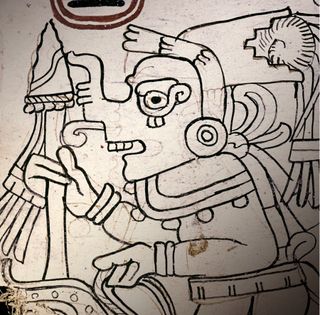
The so-called Grolier Codex (named after a club in New York where it was displayed) is a Maya codex that contains Maya hieroglyphs, illustrations of gods and a calendar that tracks the movements of Venus. A Mexican collector named Josué Sáenz claims that he acquired the codex from a group of looters in the late 1960s, but scholars still debate its authenticity.
Recent tests show that the paper the codex is written on dates back about 800 years. Scientists also found that the text was illustrated with a paint known as "Maya blue," which wasn't synthesized in a lab until recently.(That suggests it would have been nearly impossible for a forger to create it and the codex.) The tests, along with studies of the images and hieroglyphs, has led some researchers to conclude that the codex is authentic.
Handbook of Ritual Power
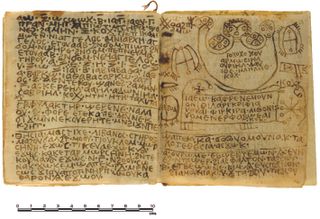
This 20-page codex dates back around 1,300 years and is written in Coptic. It contains a variety of magical spells and formulas, including love spells, spells for curing black jaundice and instructions on how to perform an exorcism.
The text may have been written by a group of Sethians, an ancient Christian sect who held Seth, the third son of Adam and Eve, in high regard. The opening of the text references a mysterious figure named "Baktiotha," whose identity is unknown.
"I give thanks to you and I call upon you, the Baktiotha: The great one, who is very trustworthy; the one who is lord over the forty and the nine kinds of serpents," a translationof the text reads.
The researchers who translated and analyzed the text call it a "Handbook of Ritual Power." It is now housed at the Museum of Ancient Cultures at Macquarie University in Sydney. The university purchased the codex in 1981 from a Vienna-based antiquities dealer named Michael Fackelmann. Where Fackelmann got it from is unknown.
Voynich Manuscript

Carbon dated to the 15th century, this 250-page book contains images of plants, cosmological symbols and nude women. It also contains an unreadable script (although one scientist believes he has deciphered 10 words from it).
Discovered in 1912 by Wilfrid Voynich, an antique-book dealer, the text has not yet been deciphered, leading to speculation as to whether it's written in a lost language, a code or gibberish. A recent study suggests that the manuscript's text has some of the hallmarks of a real language.
The manuscript has attracted a lot of attention from scholars and amateurs alike, along with a Spanish publisher that plans to republish the book in its entirety. The manuscript is now held at Yale University.
Sign up for the Live Science daily newsletter now
Get the world’s most fascinating discoveries delivered straight to your inbox.

Owen Jarus is a regular contributor to Live Science who writes about archaeology and humans' past. He has also written for The Independent (UK), The Canadian Press (CP) and The Associated Press (AP), among others. Owen has a bachelor of arts degree from the University of Toronto and a journalism degree from Ryerson University.